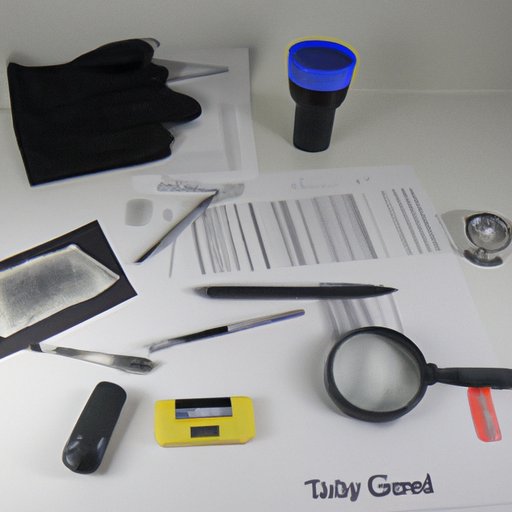Introduction
Individual evidence plays a vital role in forensic science, helping investigators to identify suspects, link them to crimes, and provide evidence in court cases. But what exactly is individual evidence? In this article, we’ll explore the definition of individual evidence in forensic science and take a closer look at how it is used to solve crimes.

Exploring the Role of Individual Evidence in Forensic Science
Individual evidence refers to any evidence that can be traced back to a specific person or object. This type of evidence is commonly used in criminal investigations to help law enforcement officers piece together clues and establish connections between suspects and crime scenes. It is often the key to cracking a case.
In some cases, individual evidence can be used to identify the perpetrator of a crime, while in other cases it can be used to link a suspect to a particular crime scene. Examples of individual evidence include fingerprints, DNA, hair samples, fiber samples, bloodstains, tool marks, ballistics, and tissue samples.

Examining the Types and Uses of Individual Evidence in Forensics
Fingerprints are one of the most common forms of individual evidence used in forensic science. Fingerprints can be left on objects or surfaces at a crime scene and can be identified by their unique pattern of ridges and valleys. They are typically used to identify suspects and link them to a crime scene.
DNA is another form of individual evidence used in forensic science. DNA is found in the cells of living organisms and is unique to each individual. It can be used to identify suspects and link them to a crime scene. DNA is also useful in establishing familial relationships between individuals.
Fibers are tiny pieces of material that can be transferred from one person or object to another. Fibers are typically used to establish connections between suspects and crime scenes. Hair samples can also be used to identify suspects and link them to a crime scene. Hair samples can be compared to known samples for comparison purposes.
A Look Inside the World of Forensic Individual Evidence
Collecting individual evidence from a crime scene requires special equipment and techniques. Investigators use a variety of tools to collect evidence, such as tweezers, magnifying glasses, and microscopes. Evidence must be carefully preserved to ensure it is not contaminated or damaged.
Once the evidence has been collected, it must be analyzed in a laboratory. Scientists use advanced technology to examine the evidence and compare it to known samples. The results of the analysis can then be used to identify suspects and link them to a crime scene.
Uncovering the Different Types of Individual Evidence Used in Forensics
Bloodstains are another type of individual evidence used in forensic science. Bloodstains can be used to identify suspects and link them to a crime scene. Tool marks are impressions left on an object or surface by a tool, such as a knife or screwdriver. These marks can be used to identify suspects and link them to a crime scene.
Ballistics is the study of the flight path of bullets. Ballistics evidence can be used to identify suspects and link them to a crime scene. Tissue samples can also be used to identify suspects and link them to a crime scene. Tissue samples can be taken from the body of a victim or from items at the crime scene.

An Overview of How Individual Evidence is Used in Crime Scene Investigations
Individual evidence is used to identify suspects and link them to a crime scene. It can be used to determine whether a suspect was present at a crime scene, or if they had contact with certain objects or people. It can also be used to establish a timeline of events and provide additional information about a crime.
Individual evidence can also be used to prove or disprove an alibi provided by a suspect. It can be used to establish links between suspects and victims, and between suspects and weapons used in a crime. Finally, it can be used to corroborate witness testimony and provide additional evidence to support a prosecution’s case.
Investigating the Significance of Individual Evidence in Solving Crimes
The value of individual evidence in forensic science cannot be overstated. It can be the key to unlocking the truth behind a crime and providing justice for victims. According to a study conducted by the National Institute of Justice, “fingerprints were the most frequently used form of individual evidence, followed by DNA and firearms evidence.”
Individual evidence can also have a significant impact on court cases. Prosecutors can use individual evidence to build a strong case against a suspect and convince a jury of their guilt. Conversely, defense attorneys can use individual evidence to raise reasonable doubt and cast doubt on the prosecution’s case.
Conclusion
This article has explored what individual evidence is in forensic science and how it is used to solve crimes. We examined the different types of evidence used, such as fingerprints, DNA, fibers, hair samples, bloodstains, tool marks, ballistics, and tissue samples. We also looked at how individual evidence is collected and analyzed, and discussed its significance in solving crimes. Ultimately, individual evidence can be invaluable in helping investigators identify suspects, link them to crimes, and provide evidence in court cases.
(Note: Is this article not meeting your expectations? Do you have knowledge or insights to share? Unlock new opportunities and expand your reach by joining our authors team. Click Registration to join us and share your expertise with our readers.)
